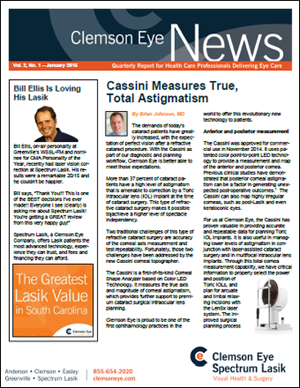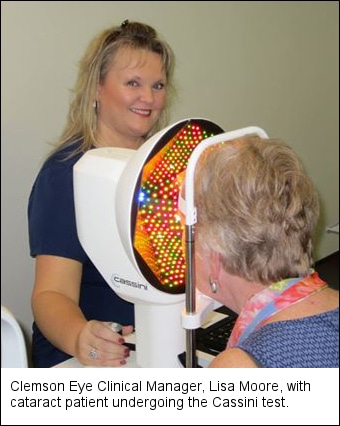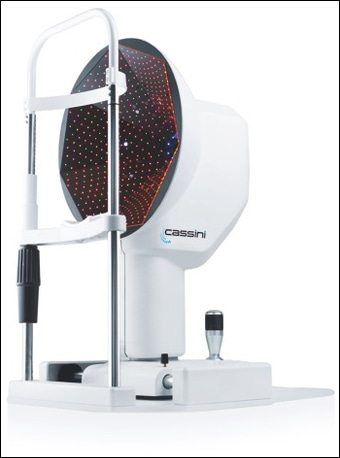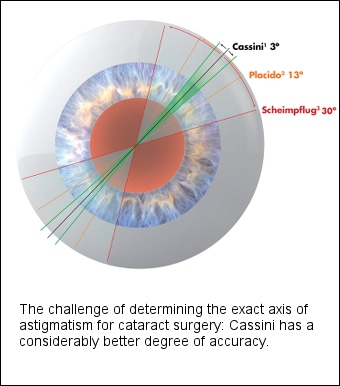Posted by: Clemson Eye in News

By Dr. Brian Johnson
Clemson Eye News, January 2015
The demands of today’s cataract patients have greatly increased, with the expectation of perfect vision after a refractive cataract procedure. With the Cassini as part of our diagnostic and planning workflow, Clemson Eye is better able to meet those expectations.

More than 37 percent of cataract patients have a high level of astigmatism that is amenable to correction by a Toric intraocular lens (IOL) implant at the time of cataract surgery. This type of refractive cataract surgery makes it possible to achieve a higher level of spectacle independency.
Two traditional challenges of this type of refractive cataract surgery are accuracy of the corneal axis measurement and test repeatability. Fortunately, those two challenges have been addressed by the new Cassini corneal topographer.
The Cassini is a first-of-its-kind Corneal Shape Analyzer based on Color LED Technology. It measures the true axis and magnitude of corneal astigmatism, which provides further support to premium cataract surgical intraocular lens planning.
Clemson Eye is proud to be one of the first ophthalmology practices in the world to offer this revolutionary new technology to patients.
Anterior and posterior measurement
The Cassini was approved for commercial use in November 2014. It uses patented color point-to-point LED technology to provide a measurement and map of the anterior and posterior cornea. Previous clinical studies have demonstrated that posterior corneal astigmatism can be a factor in generating unexpected post-operative outcomes.1 The Cassini can also map highly irregular corneas, such as post-Lasik and even keratoconic eyes.
For us at Clemson Eye, the Cassini has proven valuable in providing accurate and repeatable data for planning Toric IOL implants. It is also useful in managing lower levels of astigmatism in conjunction with laser-assisted cataract surgery and in multifocal intraocular lens implants. Through this total cornea measurement capability, we have critical information to properly select the power and position of Toric

Legacy cornea measurement systems
Without the Cassini, eye surgeons must depend on multiple corneal measurement systems to approximate the detailed and accurate data the Cassini test provides. Typically, with commonly used Placido ring-based systems there are challenges with measuring irregular corneas that can lead to inconsistent data.
With the Scheimpflug system, there are repeatability challenges because extended scanning time can lead to motion artifacts, distortion and blurring of data. Cassini solves both challenges in terms of accuracy, speed and precision.
Axis and magnitude of astigmatism
The Cassini is all about true axis with repeatability. Studies show an impressive repeatability of below three degrees2 in steep cases. With the Placido ring-based system’s reported 15 percent error rate and Scheimpflug’s error rate of up to 30 percent, a patient could lose up to 50 percent of the Toric power when the lens is implanted. With the Cassini we have superior measurement, and as a result superior outcomes.

Why is this important? Currently, there are 3.5 million cataract procedures done annually in the United States. Less than 10 percent of eligible patients opt for some level of astigmatism correction during their cataract surgery. The opportunity to have fully corrected vision post-cataract surgery, regardless of age, is a highly attractive option for patients who want the quality of life that excellent vision brings.
The Cassini has brought us a significant step further in evaluating the true total astigmatism of each cataract patient’s eye and providing them with optimal correction during cataract surgery.
Brian Johnson, MD, is a Clemson Eye ophthalmologist specializing in cataract surgery and comprehensive medical eye care
1. Koch DD, Ali SF, Weikert MP, Shirayama M, Jenkins R, Wang L. Contribution of posterior corneal astigmatism to total corneal astigmatism. J Cataract Refract Surg. 2012 Dec;38(12):2080-7.
2. Kanellopoulos AJ, Asimellis G, Friess DW. The Clinical Impact of Color LED Topographic Variability Analysis. CRS Today, April 2014.